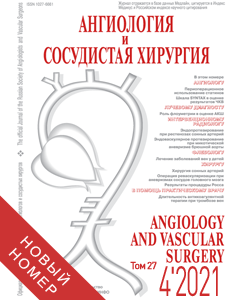Journal «Angiology and Vascular Surgery» •
2016 • VOLUME 22 • №2
Remote results of veno-venous bypass operations in post-thrombotic disease
Pokrovsky A.V.1,2, Ignatyev I.M.3,4, Gradusov E.G.2
1) Institute of Surgery named after A.V. Vishnevsky under the RF Ministry of Public Health,
2) Russian Medical Academy of Postgraduate Education, Moscow, Russia
3) Interregional Clinical Diagnostic Centre,
4) Kazan State Medical University of the RF Ministry of Public Health, Kazan, Russia
The present study was aimed at analyzing the remote results of the operation of cross-over autovenous bypass at terms varying from 2 to 28 years in a total of 68 patients presenting with unilateral post-thrombotic occlusive lesions of iliac veins and in 12 patients operated on for obstruction of the femoral vein (saphenopopliteal bypass grafting).
The obtained findings showed that a decisive factor of successful cross-over bypass grafting was a sufficient diameter of the autovenous transplant (not less than 7-8 mm).
It was determined that in 70.6% of patients the cross-over bypass grafts become dilated with time and thus provide adequate outflow of blood from the affected extremity. Studies of the phlebodynamics in the diseased limb under the conditions of an open and cross-clamped shunt demonstrated that in 72% of patients the main function on carrying out venous return is performed by a cross-over shunt. Some shunts (20.7%) undergo pathological transformation in the form of deforming ectasias and cicatricial stenosis, which in many cases deteriorates the conditions of the outflow of blood and requires secondary surgical correction of the shunts. These operations were successfully performed in patients in the remote terms.
Patency of the grafts at 15 years of follow up amounted to 79.6%. There was significant improvement of the outcomes of the bypassing operation observed in application of distal arteriovenous fistulas. A permanent clinical effect was achieved in 74.4% of patients with the functioning shunts.
Patency of the saphenopopliteal shunts within the follow-up terms up to 12 years amounted to 91.7%. The remote results showed their reliable function and improvement of the regional phlebodynamics. It was determined that the shunts could function for a long time, not undergoing pathological ectasia.
Forty-eight patients during dynamic follow up were subjected to operations on superficial and perforant veins with predominant application of minimally invasive technologies.
KEY WORDS: post-thrombotic obstruction of iliac veins, obstruction of the femoral vein, cross-over bypass grafting, duplex scanning, venous haemodynamics.
P. 98
ARCHIVES MAGAZINE
2021 (Vol.27)
2020 (Vol.26)
2019 (Vol.25)
2018 (Vol.24)
2017 (Vol.23)
2016 (Vol.22)
2015 (Vol.21)
2014 (Vol.20)
2013 (Vol.19)
2012 (Vol.18)
2011 (Vol.17)
2010 (Vol.16)
2009 (Vol.15)
2008 (Vol.14)
2007 (Vol.13)
2006 (Vol.12)
2005 (Vol.11)
2004 (Vol.10)
2001 (Vol.7)
2000 (Vol.6)
1999 (Vol.5)
1998 (Vol.4)
1997 (Vol.3)


